VR BLOG
VIRTUAL REALITY 3D
Is VIRTUAL REALITY the future of Stereoscopy?
Article written for STEREOSCOPY Magazine Issue 4 2019
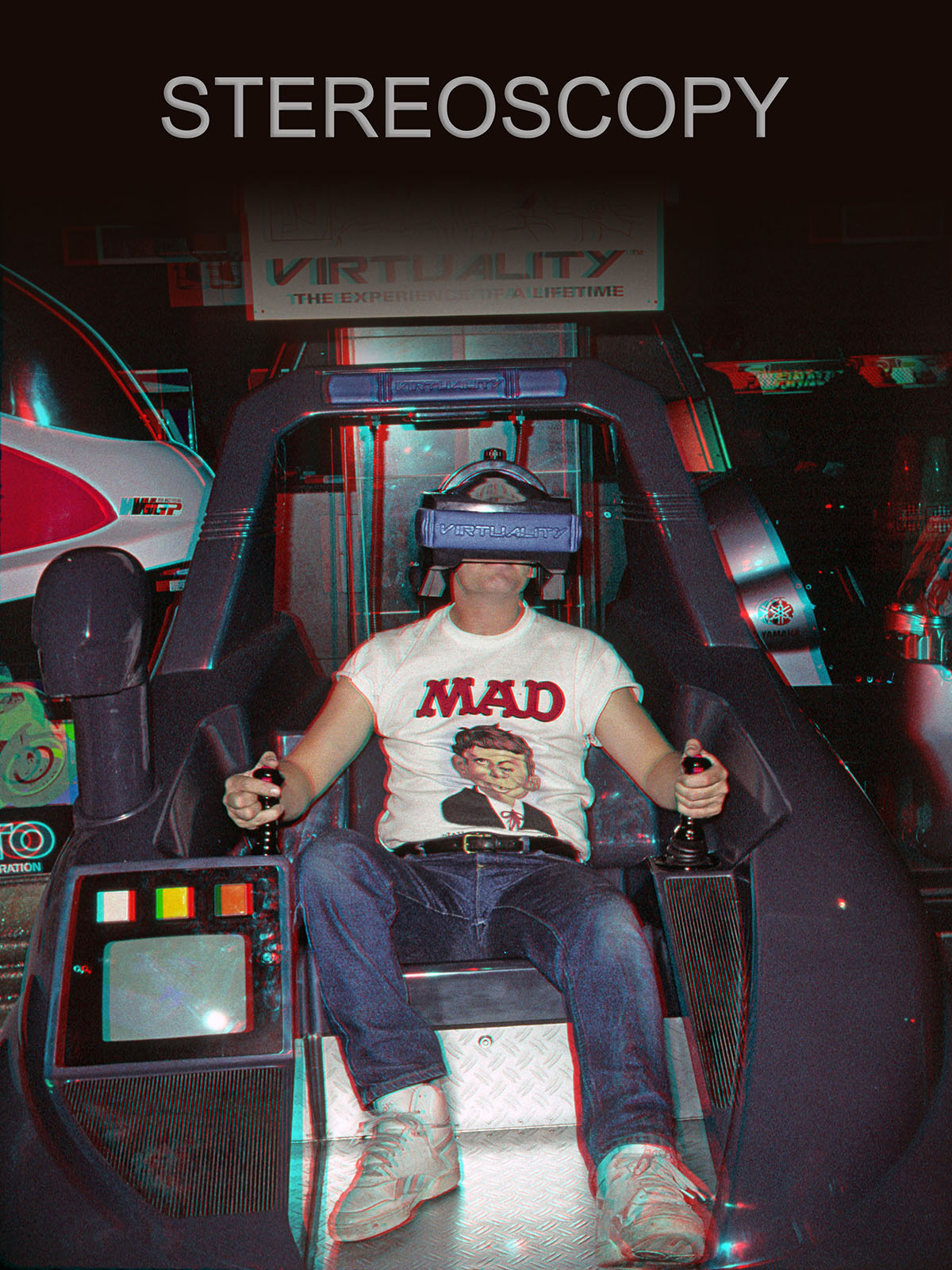
Cover of STEREOSCOPY ANAGLYPH mockup... Ron Labbe at VIRTUALITY STATION London 1991
I say YES!
Stereoscopic images have never been easy to share; they’ve almost always needed a viewing device. Print viewers were fairly common at the turn of last century, while film viewers were mass marketed for only about 10 years through the 1950’s. View-Master was the outlier, having produced millions of viewers since 1939. But what viewers are available for digital stereo? HMDs. The beauty of digital imaging is the ability to share easily- the number of flat images taken and shared each and every day is staggering… but it’s not so easy for stereo! Digital stereo had gotten some hardware support for a few years, but little public interest led to almost every piece of taking/viewing equipment disappearing for good. Online viewing is basically limited to those who can free-view or have anaglyph glasses (or one of the rare 3D monitors). Even the one stereo-centric website I know of (phereo. com) has suffered from lack of support with blackouts being common (and it may well disappear entirely by the time this article is published). So what do you do with your stereo photos? Who gets to see them, aside from some folks who go to your home or the occasional 3D meeting? Remarkably, millions of new stereo viewers are in the hands of consumers in the form of HMDs (Head Mounted Displays) that can easily access your stereo imaging as well as 3D from around the world. Most owners don’t know anything about stereo and couldn’t care less (similar to many View-Master fans). In addition, new VR stereo cameras are being sold for this new VR system (though traditional digital pairs stereo can be also viewed in a headset). There is no question that digital imaging technology is constantly improving, so we can certainly expect VR headset and camera quality to keep advancing. In the late 1980’s I was introduced to the very impressive LEEPVR photography system: 120 film in specially built super-wide lensed 3D camera with the matching viewer. The inventor, Eric Howlett, subsequently tried to utilize the extremely immersive lenses to work with video, but the tech was not nearly advanced enough: the 1992 “Cyberface 2” utilized dual Sharp color 385 x 119 pixel LCDs. (I personally never saw one… there’s plenty of info on this system here.)
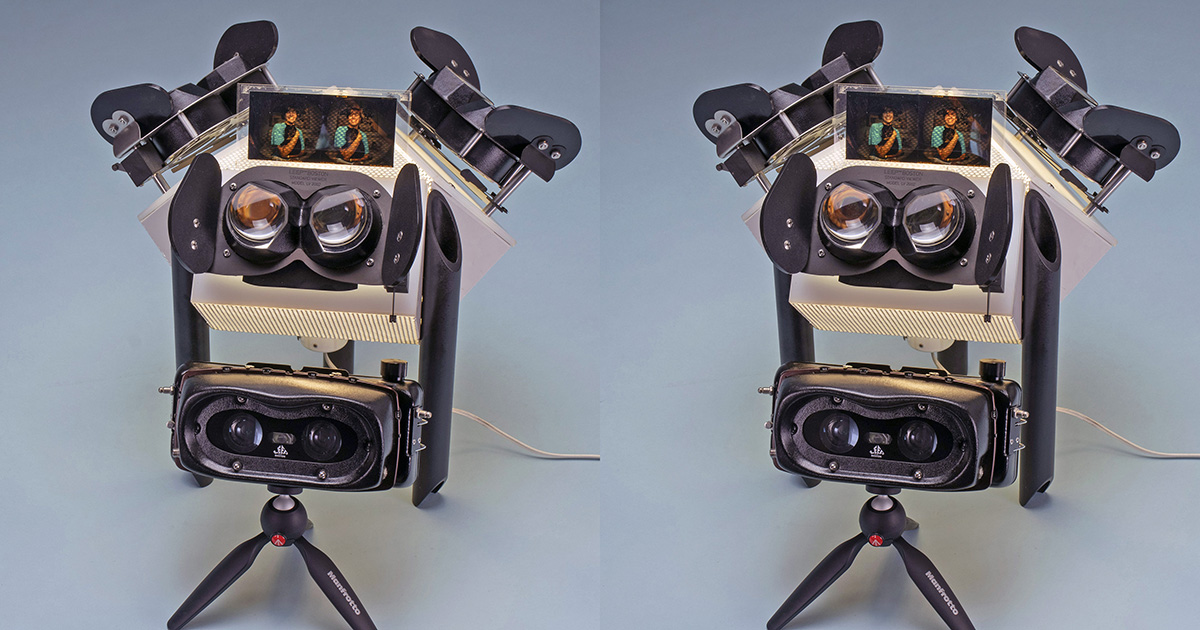
Rare LEEP Triple Head Viewer stand with Camera circa 1989
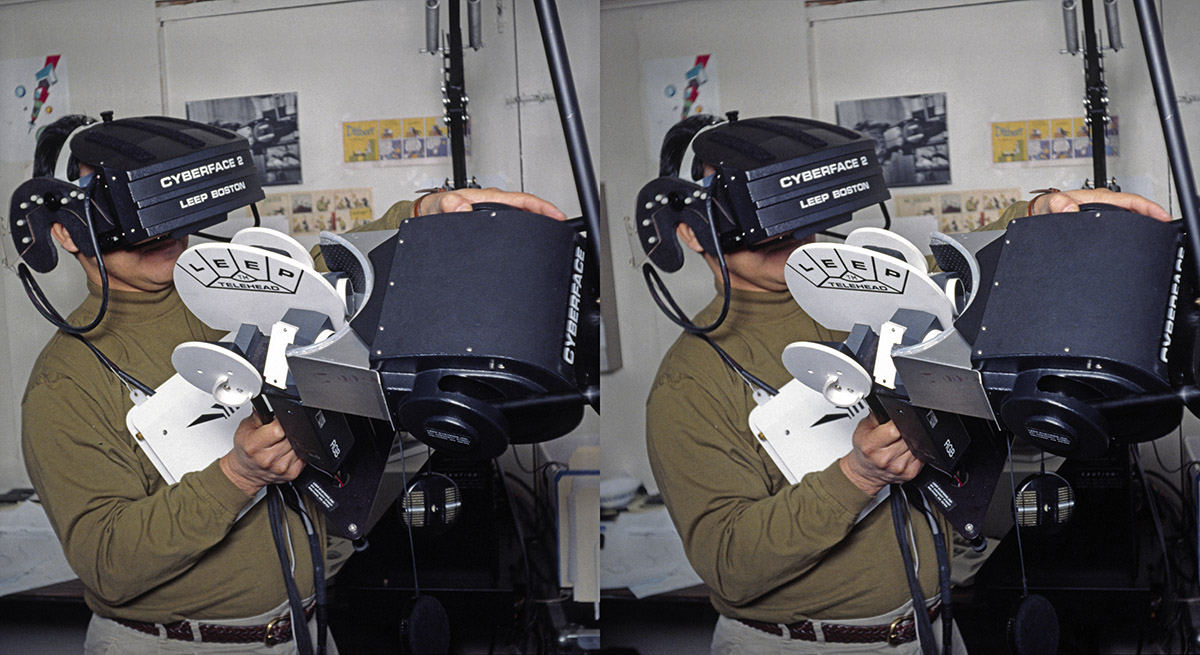
LEEP Employee Greg Rivera with Cyberface 1 and 2 with Telehead, 1992
My first exposure to a video headset was in 1991 when I experienced the arcade system called VIRTUALITY in London. My memory was that it was (not surprisingly) quite rudimentary in terms of computer graphics and insanely bulky, but it was stereo (dual 372x276 LCDs), and the interaction/immersion was profound. Different versions were shown at a Virtual Reality Expo in Boston several years later. I also viewed an early full color VR system at Disney World in 1999: “Aladdin’s Magic Carpet Ride” at DisneyQuest exhibit (shut down in 2016). A number of VR systems were developed throughout the 1990’s, but it would take 20 years for computer power and image resolution to bring VR to a viable state.
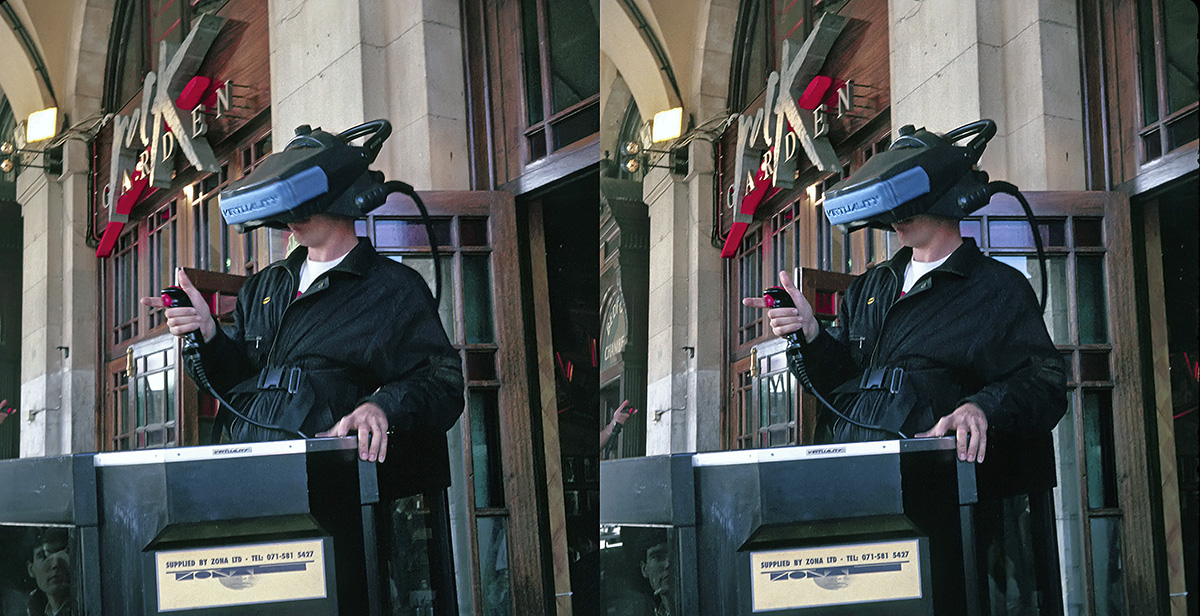
Ron Labbe VIRTUALITY at Rock Garden UK Oct 1991
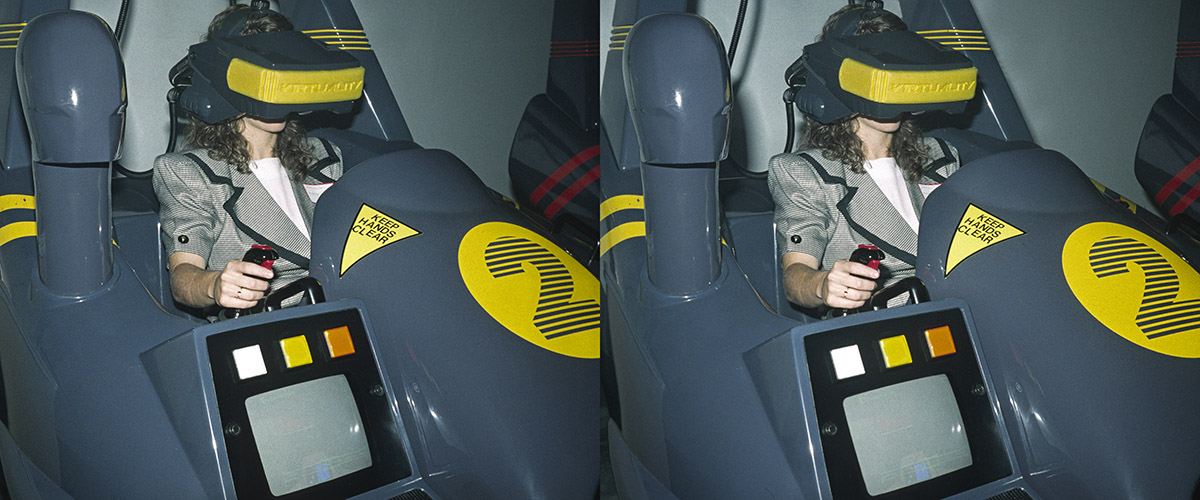
VIRTUALITY Station Ride Virtual Reality Expo Boston 1993
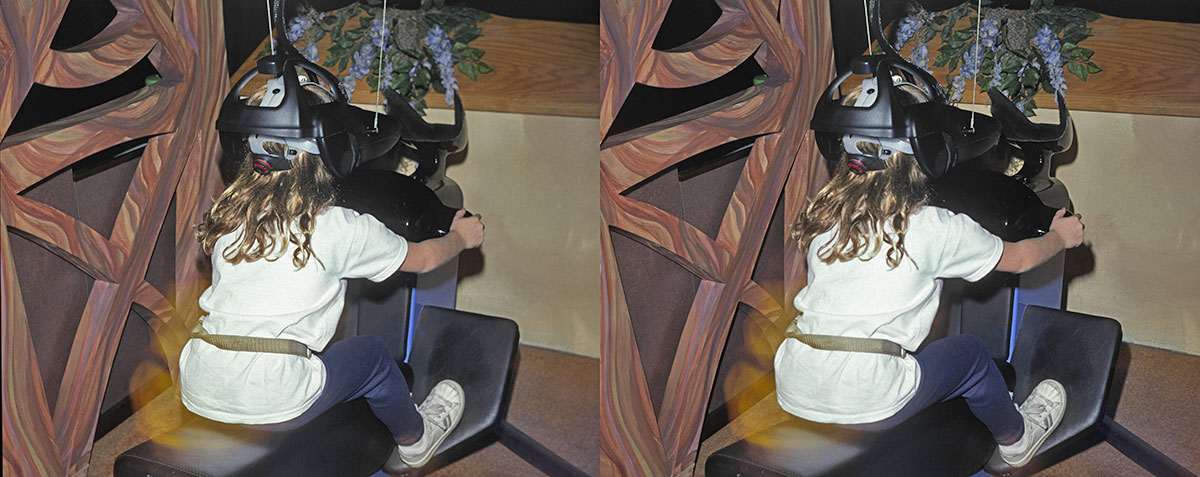
Aladdin VR Ride DisneyQuest 1999
In 2013 John Ribarich shared an Oculus RIFT “Development Kit” in his room at a National Stereoscopic Association convention in Traverse City, MI. Apparently, it was not that impressive as I don’t recall the imaging at all! (NOTE: Oculus RIFT was Kickstarted in 2012. Two years later Facebook purchased Oculus for $2 billion.) However, at the 2016 NSA convention 3 years later in Tulsa, OK, Franklin Londin shared some 360 3D VR in his Gear VR headset that nearly blew my head off (similar to the experience of me seeing my first Realist transparency pair). We saw amazingly immersive short documentary videos by Felix and Paul which put me inside a Maasai hut and on a handmade wooden boat to visit people living in stilt homes above the water off the Borneo coast. I guess running these 360 stereo video was intense for his Samsung S6, as he had to occasionally cool it off in the room’s mini-fridge freezer! Back home I was soon playing with “Google Cardboard” headsets, both paper and plastic, with my LG smartphone. The interface was very limited (a single “button” that sometimes worked), but there were a number of apps (including 3DStereoid PRO) that allowed viewing of stereo images and video.

Oculus Rift demo Best Buy Feb 2017
In Feb of 2017 I went to the local BEST BUY to check out an Oculus RIFT demo with my 3D friend Rob… it was VERY compelling! What astounded me was the “six degrees of freedom” that allows you to move within a (computer graphic) space… I remember bending down to look under a table and all around the models on it. However, it was expensive, and I didn’t like that it wasn’t portable (needing to be tethered to a powerful computer)… not easy to share. Instead, I purchased a Gear VR and (used) Samsung smartphone system in August of 2017, and found it much easier to navigate via the hand controller. My friend Lattie Smart, from his home in Maryland (I live in Massachusetts), showed me around some of the amazing apps, including VTime: you can (via your “avatar”) chat with up to four people (each having their own avatars) in a virtual “room” to share stereo images (which you’ve uploaded to the VTime website) on the virtual projection screen! The resolution, of course, is not great, but still impressive. The first digital projections at NSA 1998 were from the groundbreaking Vrex projector that showed 720x240 (interlaced NTSC) per eye! Since Gear VR is supported by Oculus, it offers the similar “home page” interface that allowed much easier navigation between apps than the Cardboard (which demanded pulling the phone between operations).
Moving to the Oculus GO (1280x1440 per eye) in May 2018 was an easy choice since the display as well as the stereo speakers were integrated (the sound was surprisingly good considering the speakers are built into the straps!) It featured the same familiar homepage as the Gear VR, along with an easy way to load images or video via USB cable. Of course, I became very interested in shooting my own immersive stills and video, and I’d been looking at lots of the work done by others online. Mainly, there are 180 and 360 formats. Seems all 180 is stereoscopic, while most 360 is 2D. I found 360, even if 3D, often problematic- I really don’t like the feeling that I’m missing something behind me and it’s not fun to constantly crane one’s neck around, especially if not in a swivel chair (or standing). If 360 is 2D, it looks to me as though the scene in projection mapped inside a ball that you’re inside of. In addition, 360 videos (or stills) require “stitching” of at least 2 fisheye images, which may or not be seamless. And when the camera sees in all directions, it’s very hard to extricate the cameraman, crew, lights or anything else you don’t want in the picture. For me, 180VR (3D) makes the most sense… So, in February 2019, the VUZE XR VR camera came out ($439) to very good reviews. It can be used with lenses back to back for 360, but with the press of a button the lenses flip to side by side for 180. The first thing I had to learn was that you cannot hold the handle while shooting or your fingers will get in the image! You really have to think of a geometric plane exactly flush with the lenses that comprise the edges of what is seen: The left lens curve is actually in the right eye view! Video is 5.7mb/30fps, stills render at 3000x3000 pixels per eye. That’s a good amount of resolution, but of course it’s spread out to top, bottom, left and right edges. The lack of resulting sharpness is made up for by the immersion factor… and the resolution will only improve with better lens design, denser displays and faster/smaller computer power. And of course HMDs will get smaller and more comfortable. I’m not a gamer, but when I got a PlayStation 3 many years ago to play 3D Blu- Rays, I also got a few 3D games to see how good they were. None caught my interest for more than a few tries. The best (2D) game I’d ever tried was called “Neverhood,” a “claymation” puzzle game for Windows 95. So I thought I’d try to find some puzzle games (amongst the myriad shooters) and a few were spectacular! When the RIFT S became available in June 2019, I grabbed one since I really wanted to see state-of-the art gaming in the “six degrees of freedom” environment. Of course, all of these games are computer graphics, which I’ve always loved at the cinema (especially in 3D), and now total immersion can be had. In addition, there are some incredible videos (along with many poor ones). Just as there are people who complain of nausea with 3D movies, there are VR experiences that are even more likely to induce headache, certainly shaky or fast moving video as well as game action that tracks poorly or moves too quickly. As developers (and hardware) mature, most of these issues will subside.
For centuries, people have looked at images in some kind of frame (usually a rectangle). In stereo, we call this the stereo window. For the first time, that boundary is erased: There is no window; you are virtually within the space. I think this is a huge leap in imaging technology, and the tech is truly in its infancy. People with whom I’ve shared the GO experience almost always express amazement (more so than other forms of stereo imaging, and I’ve shared a few). It’s hard to know whether HMDs will catch on with the “masses,” but it’s definitely on an upward trend, with no end in sight. In addition to being used for virtual travel, education, sales and training, there’s also augmented reality, mixed reality and other technologies. Right now, it’s virtual reality that is piquing my interest. I urge you to give it a try.
